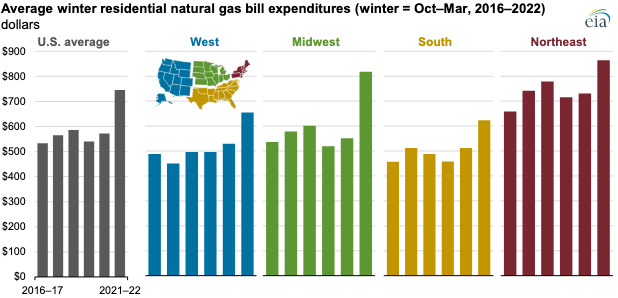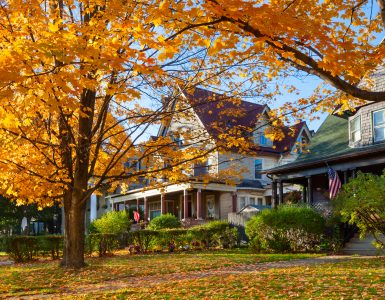This winter could be an expensive one for home heating bills. U.S. households are on track to spend more on energy this winter than any year since at least 2014, despite predictions that it will be a mild winter across most of the country.
Consumers who burn natural gas to keep their homes warm, which includes nearly half of all U.S. households, will be hit the hardest, spending an average of $746 on fuel from October through March, the Energy Information Administration forecasts. Costs will be even higher in the Northeast and Midwest where cold weather is more common.
Home heating oil and propane could cost more than natural gas, according to estimates. Homes heated by electricity will only see modest increases of about 6%.
Source: U.S. Energy Information Administration, Winter Fuels Outlook
While you can’t do much about the rising energy costs of fuel this winter, there are many ways to reduce how much energy you use (and reduce your energy bills in the process.) With cold winter winds already blowing, here are ideas for reducing energy consumption, from energy saving tips like inexpensive fixes to bigger investments that pay off over the long run.
Low Cost Fixes
Mind the gap
Shrunken sashes, crumbling caulk and worn-out weatherstripping can leak a lot of heat on a cold winter day, leading to significant heat loss from air leaks. Fortunately, you can fix these problems inexpensively yourself to improve your energy efficiency. Use caulk from a local hardware store to fill gaps less than one-quarter-inch wide on the non-movable parts of your windows and weatherstrip parts that move. Outside doors should be well-sealed, as should less-obvious leak locations, such as electrical outlets, baseboards and attic hatches. Filling gaps help householders save an average of 10% to 20% on heating and cooling, or up to $166 a year. Weatherstripping windows can save an additional 5% to 10%, or as much as $83 a year by minimizing air flow.
If you don’t have storm windows, you can add a layer of protection with an inexpensive window insulating kit from the hardware store. They use plastic film to create a sealed air pocket that keeps cold air out of your living space (and warm air in!)
A bright idea
Switching to energy-efficient lighting is a good idea any time of year, but especially in winter, when long nights make us keep the lights on longer. Swapping out incandescent bulbs for energy-efficient LEDs is a no-brainer because you can have the same amount of light for a fraction of the cost. That matters because lighting accounts for about 15% of an average home’s electricity consumption. The U.S. Department of Energy reckons that installing LED bulbs can save the average household about $225 a year. Remember to replace light bulbs in exterior lights, especially those that stay on all night.
Always on guard
People are often surprised to learn how much energy some devices slurp up even after you think you turned them off. Sound bars, cable boxes, game consoles and computers are some of the devices that use energy in idle mode. This is known as your “Always On” load and a data analysis by Sense indicates it accounts for 23% of the average homeowner’s energy usage. To start, consider buying a smart power strip that turns everything off completely when you leave a room. Sense offers other tips to reduce your Always On load in this guide.
Moderate Cost Maintenance
Furnace tune-up
Before temperatures drop much further, schedule routine maintenance on your furnace to increase efficiency and reduce operating costs. While you can change air filters and check fluid levels yourself, professional maintenance is a wise investment. A service visit could include a long list of items, such as clearing the flue, lubricating moving parts, checking for rust, testing controls and replacing filters if needed. Furnace tune-up costs depend on where you live and the age and what kind of heating system you own, but generally range from $75 to $200.
Energy audit
Not sure where to start looking for ways to save energy at home and reduce utility bills? A professional home energy audit can help you prioritize. Energy auditors inspect your home room-by-room using carbon monoxide detectors, infrared cameras, moisture meters, non-toxic smoke pens or other equipment, then suggest improvements based on their findings. Audits usually cost from $200 to $700. Auditors will recommend solutions like a programmable thermostat (or some smart thermostats) to help with high heating costs and curb your energy usage.
Tighten Your Home’s Envelope
New homes are significantly better insulated than older ones, so if you live in an older house, there’s a good chance you’re paying for heat that leaks out through the walls and attic. The answer: better insulation. Many utilities offer free home energy audits that are less elaborate than the ones done by professionals, but they can discover where heat is leaking and insulation can help tighten your envelope. Check to see if your state offers rebates on insulation work, also.
Big-ticket Improvements
Stay warm, save money
Home heating accounts for 43% of the energy consumed by U.S. homes, making it a good place to look for significant energy savings. Innovative alternatives to 20th century furnaces and boilers make it easier to not only save energy but lower your utility bill and shrink your carbon footprint.
Most American homes are still heated by either a furnace, which heats air, or a boiler, which heats water (and are different from a water heater). Older versions of these systems have annual fuel utilization efficiency (AFUE) ratings as low as 56%-which means they convert as little as 56% of the chemical energy in their fuels into thermal energy for a house. The missing energy escapes up the flue as waste heat.
New, high-efficiency systems, such as condensing gas furnaces, have AFUE ratings of 90% to 98.5%. Heat pumps are dramatically more efficient: 300% for air source models and 600% for ground source models. (Three hundred percent efficiency means that for every kilowatt of electricity a heat pump uses to operate, it produces 3 kilowatts of thermal energy.)
While air source heat pumps halve the energy consumed by a single-family home, they can, by one estimate, cost $4,500 to $8,000 to buy and install. If you plan to be in your home for many years or your current heating system is failing, a heat pump system could be an investment worth making this winter to lower your energy bills in the long-term.
Upgrade your windows
Caulking and weatherstripping drafty old windows will conserve only so much energy. The heat lost through windows in winter and gained through windows in summer are responsible for 25% to 30% of residential heating and cooling energy use.
You can curb those losses by installing new energy efficient storm windows or replacement windows. Window prices and quality can vary widely. Storm windows can produce similar savings to replacement windows but are typically a third of the cost. They can be applied inside or outside the existing window. For the best energy savings, look for storms that are certified by the Attachment Energy Rating Council (AERC).
Replacing the entire window is more expensive. The cost of replacement windows varies by their materials, energy ratings, whether they are double or triple paned, and other features. For instance, replacing ten 3-by-5-foot double-hung windows, with insulated, low-emissivity, simulated-divided-light units can cost more than $19,000 . Aluminum windows are the least expensive but not as energy efficient as vinyl, composite or wood. In every case, use the energy rating as a guide, and keep in mind that windows are a long term investment in your home.
Tax Credits and Rebates
Conserving energy and reducing carbon emissions are a public good as well as a private benefit, so the government offers homeowners financial aid to meet the large upfront costs of some of these projects. The federal government, for example, allows people who buy a geothermal heat pump to reduce their tax bill by 26% of the amount they paid to purchase and install the system. Energy Star’s website has a feature that enables you to search for federal credits and rebates that can help offset some of the expense of retrofitting your house with energy-saving technologies to minimize energy waste.
State and local governments as well as some utility companies also offer financial help for qualified homeowners. Several online databases are available to help homeowners find programs suitable to their needs. One is a nonprofit group supported by builders and equipment makers that is seeking to accelerate the change to net-zero housing.



















